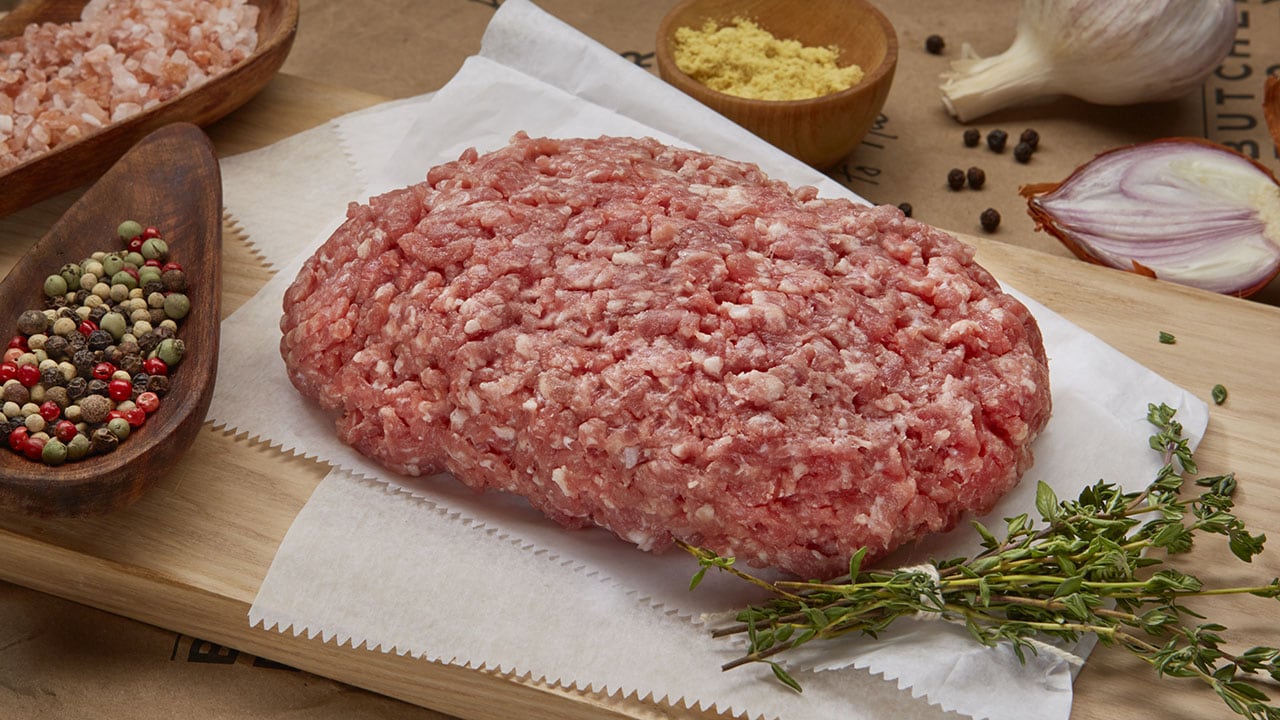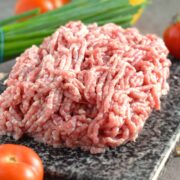It’s easy to make your own ground pork, so you can always have it on hand for when you want fresh meatballs. This short guide will show you how to buy, grind, and store ground pork meat at home so that you can use it in many recipes.
In the past, I have never bought ground meat from the store, whether it was pork, beef, or chicken. Many people think why go through all that trouble when you can buy ready ground pork. The reason is that when I work with meat, I like to know how clean the meat I’m eating is. I make sure that my ground meat doesn’t have any blood vessels or other things that aren’t needed. I am very picky when it comes to meat! .
When you cook it yourself, you get the solid meat and a little fat, which makes the food tasty and not dry. The best way to satisfy my expectations is to buy meat myself, grind and store by freezing. You can even use this ground pork to make homemade sausages.
Ground pork is a versatile meat that can be used in everything from sausage to meatballs to burgers. But not all cuts of pork work equally well for grinding. The right ratio of fat to lean meat is crucial for achieving the perfect texture and flavor. So what’s the best cut of pork for homemade ground pork? Let’s break it down.
Shoulder Is the Ideal Cut
The clear winner for ground pork is pork shoulder, also known as Boston butt or pork butt. This economical cut comes from the upper part of the front leg. It contains a good balance of fat and muscle, usually around 20-30% fat content. That balance makes pork shoulder perfect for grinding.
When ground, the fat keeps the meat moist and tender. The lean meat provides enough structure so the ground pork doesn’t get mushy or paste-like. Pork shoulder also has great flavor that comes through beautifully in sausages, meatballs and other ground pork dishes. This versatility explains why butchers traditionally use pork shoulder for store-bought ground pork.
The 80/20 Blend
An ideal ratio for ground pork is 80% lean meat to 20% fat simply known as the 80/20 blend. This ratio provides enough fat for moistness and flavor while still delivering a meaty texture. Too little fat can make ground pork dry and crumbly when cooked. Too much fat results in greasy soft ground pork.
Conveniently, pork shoulder naturally contains about 20-30% fat. This means you can grind pork shoulder without any added fat and end up with a near perfect 80/20 ratio. It doesn’t get much easier than that!
Other Cuts to Consider
While pork shoulder is the top choice a few other pork cuts can work nicely for grinding
-
Pork leg also called fresh ham, contains less fat than the shoulder at about 10-15%. Use an 85/15 blend for best results.
-
Pork belly is very fatty at around 50% fat. For ground pork, blend belly with a leaner cut like loin or leg.
-
Pork jowl offers high fat content similar to belly. Use in moderation in blends.
-
Spare ribs work well ground due to marbling and fat between bones. Remove bones first before grinding.
Why Fat Ratio Matters
You may be wondering why the fat ratio matters so much in ground pork. Here are some key reasons:
-
Moistness – Fat keeps ground pork juicy and succulent during cooking. Without enough fat, ground pork can become dry, crumbly and tough.
-
Flavor – Fat carries and distributes flavor beautifully. Higher fat recipes like sausage and meatballs get big flavor from the fat.
-
Texture – Some fat gives ground pork a smooth, supple mouthfeel. Too little fat makes it dense and grainy.
-
** binder** – The fat acts as a binder to hold ground pork together, especially in sausages. This helps ground pork keep its shape when cooked.
Grinding Tips for Best Results
Now that you know which cut to use, here are some useful tips for grinding pork at home:
-
Partially freeze the meat to make grinding easier. The firmness helps the meat grind smoothly.
-
Don’t overwork the meat by regrinding it too many times as that alters texture.
-
Use a coarse die for a nice chunky ground pork best suited to burgers and meatballs.
-
Choose a finer die if making sausages or a smoother mix for patties.
-
Mix in some salt and herbs for extra flavor if making bulk ground pork.
-
Grind in batches for the most control over texture and seasoning.
Storing and Freezing Ground Pork
Properly storing ground pork is important for safety and quality. Here are some tips:
-
Store ground pork in the refrigerator for 1-2 days maximum. Use within 24 hours for absolute freshness.
-
For longer storage, freeze ground pork in an airtight container for 2-3 months.
-
Portion ground pork into recipe-ready amounts before freezing for quick and easy meals later.
-
Place parchment between portions to keep them separated in the freezer container.
-
Defrost frozen ground pork overnight in the fridge, never at room temperature.
Recipe Ideas for Ground Pork
From breakfast to dinner and everything between, ground pork is incredibly versatile in the kitchen. Here are some tasty recipe ideas:
-
Breakfast sausage patties or links
-
Pork burgers with fun mix-in like blue cheese or jalapeños
-
Meatballs in tomato sauce over pasta
-
Stuffed peppers or cabbage rolls with ground pork filling
-
Dumplings and potstickers with seasoned ground pork
-
Pork Bolognese sauce for pasta, zucchini noodles or lasagna
-
Chorizo-style Mexican sausage
-
Savory meatloaf with mix of pork and beef
-
Vietnamese lemongrass pork patties called Nem Nướng
-
Chinese steamed pork buns
-
Polish pierogi stuffed with pork filling
-
Rustic pâté with chunks of meat
There are endless possibilities for delicious ways to use ground pork!
Frequently Asked Questions
What’s the ideal fat ratio for ground pork?
The ideal ratio is 80% lean meat to 20% fat, creating an 80/20 blend. This provides enough fat for moisture and flavor while still delivering a nice meaty texture.
Is it okay to use lean cuts like tenderloin for ground pork?
Very lean cuts like tenderloin don’t have enough fat for good results when grinding pork. They will produce dry, crumbly ground meat. Always add some extra fat when grinding extra lean cuts.
How can I add more fat to very lean ground pork?
Mix in pork fat trim, pork belly, bacon ends, or even high-quality lard. The added fat should make up around 20% of the total weight.
Is ground pork safe to eat raw?
No, raw ground pork should always be thoroughly cooked to an internal temperature of 160°F to avoid any foodborne illness risk. Unlike beef, pork should never be eaten raw.
How do I know if ground pork has gone bad?
Signs of spoiled ground pork include an off smell, slimy texture, or gray color. Discard ground pork if it displays any of these signs or has been in the fridge for over 2 days.
The Takeaway on Pork for Ground Pork
When it comes to the best cut of pork for grinding, look no further than the pork shoulder! With its near perfect 80/20 ratio of fat to lean meat, pork shoulder is perfectly suited to making moist and flavorful ground pork. For best results, partially freeze the meat before grinding and avoid overworking it. Store ground pork properly and use within 1-2 days for maximum freshness.
The possibilities are endless when cooking with homemade ground pork. From sausage to sliders to dumplings, ground pork adds hearty meaty flavor to all kinds of dishes. So grab some pork shoulder on your next grocery run and get ready to grind up amazing recipes!

Why I Make Homemade Ground Pork:
When I need ground pork, I always look for a sale on natural pork. It has to be natural pork, not regular pork, because the taste is different. I purchase 5-10 packs and each pack is about 3-5 lbs. I prepare it, grind it, and set aside a good amount of ground pork to make meatballs the same day and freeze them to enjoy later. I then weigh out the rest of the ground pork to the amount I need (depending on the recipes I usually make), put it in ziploc bags, flatten it out a bit, and freeze it.
If I need ground pork, I put it in the sink before bed and use it in the morning. Just don’t leave it there all day; if you can’t use it “now,” put it back in the fridge after it thaws. My husband likes fresh or fried meatballs better than frozen ones, so we often let a bag of ground meat thaw, mix in the other ingredients, and fry them in a skillet. It sounds like dinner, but for us, it can be breakfast, lunch, or dinner! If you have fresh or frozen meatballs at home, you’ll always have something to eat!
You can follow the same process to make ground beef and ground chicken. You’re going to need an electric meat grinder. (I’ve been using this pork grinder since 2013; my mom and sisters have the exact same one. Wouldn’t recommend it unless I really loved it ).
- natural pork meat
- cold water
How Do You Grind Pork at Home?
1. Cut pork meat into 1. 5-2” pieces, disposing any blood vessels or little unnecessary things and place pieces into large sieve. Optional, but I like to rinse meat pieces in cold water to wash off any blood etc. Put in sink for 5 to 10 minutes to let any extra water drain out of the sieve. Do this again when you’re ready for the next batch. Line paper towel with a cloth towel or cutting board. Place the cleaned meat on the paper towel. Use a second paper towel to pat off any extra water.
2. Grind cut meat pieces, and weigh out ground meat into plastic freezer bags. (For example, I do 2. 5 lb for oven meatballs, 1. 5 lb for fried meatballs, 8 oz for meatball soup, etc. ).
3. Press bagged ground meat down to about 1” thick so it thaws faster when you need it. Refrigerate any ground meat you’re going to use same or next day and freeze the rest. (Avoid storing ground pork meat in the refrigerator for more than 2 days).
It might not be cheaper to grind your own meat, but the taste is better and you have more control over the size and quality of the grind.
Our meat grinder is not only used to grind meat, but we also use to make cookies and use for other needs. Maverick meat grinder comes with several attachments that are very handy. It is definitely worth it getting a meat grinder, in my opinion.
We recommend checking the manufacturer’s care instructions. When in doubt, hand wash with hot soapy water.

